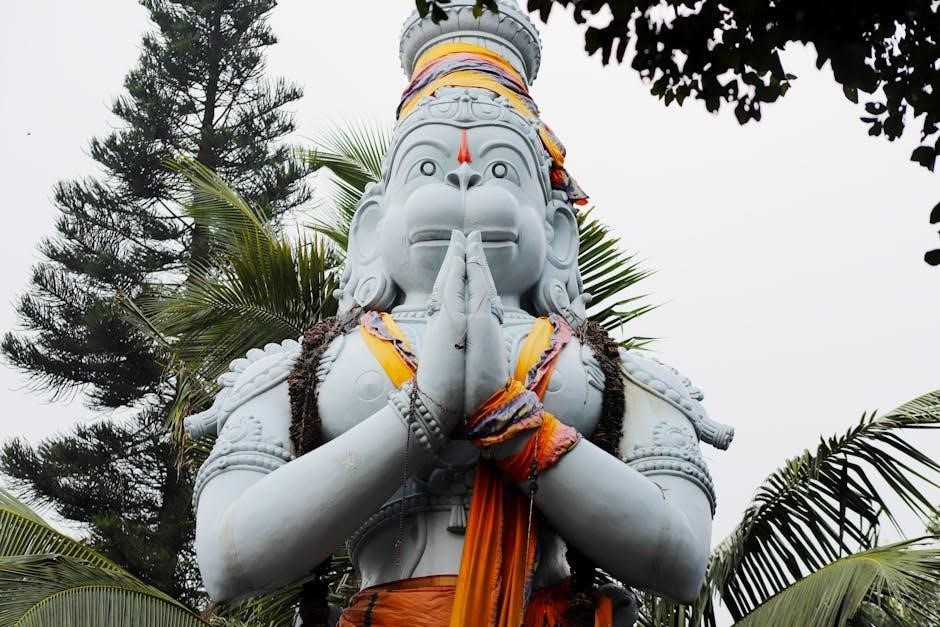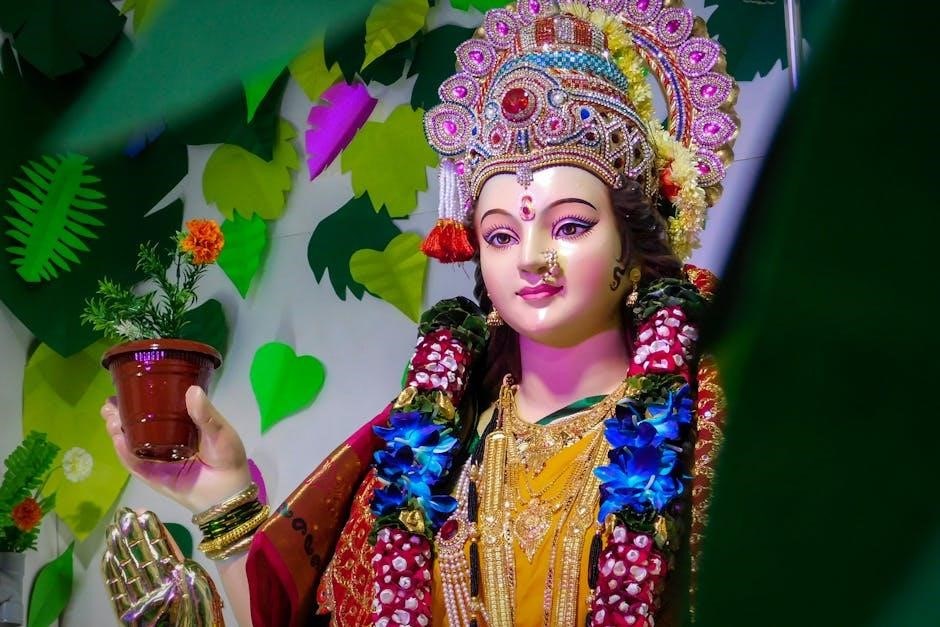hanuman chalisa in bengali pdf
The Hanuman Chalisa‚ a devotional hymn dedicated to Lord Hanuman‚ holds immense significance for devotees․ Its Bengali translation provides accessibility to the Bengali-speaking community‚ fostering a deeper connection with its profound message of devotion‚ strength‚ and unwavering faith․
Significance of Hanuman Chalisa
The Hanuman Chalisa is more than just a hymn; it’s a reservoir of spiritual energy and a pathway to connect with Lord Hanuman’s divine qualities․ Reciting it is believed to bestow strength‚ wisdom‚ and protection from negative forces․ For Bengali devotees‚ the availability of the Chalisa in their native language amplifies its impact‚ making it easier to understand and internalize its teachings․
The Chalisa serves as a reminder of Hanuman’s unwavering devotion to Lord Rama‚ inspiring individuals to cultivate similar virtues in their own lives․ It provides solace during difficult times‚ offering hope and guidance․ Its accessibility in PDF format further enhances its reach‚ allowing devotees to easily access and share this sacred text․ It is a cherished devotional practice․

Hanuman Chalisa: A Devotional Hymn
The Hanuman Chalisa stands as a revered devotional hymn dedicated to Lord Hanuman․ Composed by Tulsidas‚ it encapsulates Hanuman’s virtues and devotion‚ offering solace and guidance to those who recite it with faith․
Origin and Author: Tulsidas
The Hanuman Chalisa owes its existence to the esteemed poet-saint Tulsidas‚ a devout follower of Lord Rama and an ardent devotee of Hanuman․ Tulsidas‚ through his profound devotion and literary prowess‚ crafted this hymn in Awadhi language‚ a dialect of Hindi․
His composition aimed to make the glories of Hanuman accessible to the common people‚ fostering a deeper connection with the divine․ Tulsidas’s deep understanding of spirituality and his ability to translate complex philosophical concepts into simple verses made the Chalisa an instant classic․
His work resonated with devotees across linguistic barriers‚ leading to translations like the Bengali version‚ ensuring wider accessibility and impact․ Tulsidas’s legacy continues to inspire millions through his timeless verses of devotion․
Structure: Forty Verses (Chalisa)
The Hanuman Chalisa‚ as its name suggests‚ is structured around forty verses‚ each meticulously crafted to extol the virtues and powers of Lord Hanuman․ The term “Chalisa” itself denotes a collection of forty‚ signifying the concise yet comprehensive nature of this devotional hymn․
These verses are arranged in a logical sequence‚ starting with an invocation to Guru‚ followed by praises of Hanuman’s qualities‚ his devotion to Lord Rama‚ and his heroic deeds․ The structure allows devotees to systematically contemplate Hanuman’s attributes and seek his blessings․
Each verse encapsulates a specific aspect of Hanuman’s persona‚ creating a holistic portrayal of his divine essence․ The concluding verses typically include a plea for protection and blessings‚ reinforcing the hymn’s purpose as a tool for spiritual growth and well-being․ This structure enhances its devotional impact․
Bengali Translation of Hanuman Chalisa
The Bengali translation of the Hanuman Chalisa makes this powerful hymn accessible to Bengali speakers․ It allows them to connect with Lord Hanuman’s qualities and devotion in their native language‚ deepening their spiritual experience․
Availability of Bengali PDF Downloads
The Hanuman Chalisa in Bengali is readily available in PDF format for free download․ Several online resources and websites offer this devotional text‚ allowing devotees to easily access and recite the hymn․ These downloadable PDFs often include the original Hindi text alongside the Bengali translation‚ facilitating a deeper understanding and appreciation of the Chalisa’s meaning․
The availability of Bengali PDF downloads caters to the needs of Bengali-speaking devotees worldwide‚ enabling them to connect with Lord Hanuman and benefit from the Chalisa’s spiritual power․ This accessibility ensures that the hymn’s message of devotion‚ strength‚ and protection reaches a wider audience‚ fostering a stronger connection to their faith and traditions․ Many websites also offer options to print the PDF‚ allowing devotees to have a physical copy for personal use․
Importance for Bengali Devotees
The Hanuman Chalisa holds a special place in the hearts of Bengali devotees‚ serving as a powerful source of inspiration and spiritual guidance․ Reciting the Chalisa in their native language allows for a deeper connection to Lord Hanuman‚ fostering a greater understanding of the hymn’s meaning and significance․ This accessibility strengthens their faith and devotion‚ enabling them to experience the transformative power of the Chalisa․
For Bengali devotees‚ the Hanuman Chalisa represents a cherished tradition passed down through generations․ Its recitation is often incorporated into daily prayers‚ religious ceremonies‚ and festive occasions‚ serving as a reminder of Lord Hanuman’s unwavering devotion to Lord Rama and his ability to overcome obstacles․ The hymn instills courage‚ strength‚ and hope‚ empowering devotees to face life’s challenges with unwavering faith․

Content and Meaning of the Chalisa
The Hanuman Chalisa‚ comprising forty verses‚ encapsulates Lord Hanuman’s virtues and devotion to Rama․ Through vivid descriptions‚ the verses reveal Hanuman’s strength‚ wisdom‚ and unwavering commitment‚ inspiring devotees to emulate his exemplary qualities․
Description of Hanuman’s Qualities
The Hanuman Chalisa is rich with descriptions of Hanuman’s exceptional qualities‚ portraying him as an epitome of strength‚ wisdom‚ and devotion․ The verses highlight his unparalleled physical prowess‚ depicting him as “Bajrangbali‚” the one with a body as strong as a thunderbolt․ His intellect and knowledge are also emphasized‚ recognizing him as “Gyan Guna Sagar‚” the ocean of knowledge and virtues․
Furthermore‚ the Chalisa celebrates Hanuman’s unwavering loyalty and selfless service to Lord Rama․ He is described as “Ramdoot‚” the supreme messenger of Rama‚ highlighting his dedication and commitment to his divine master․ These descriptions serve to inspire devotees to cultivate similar virtues in their own lives‚ striving for physical and mental strength‚ as well as unwavering devotion․
Devotion to Lord Rama
Central to the Hanuman Chalisa is the unwavering devotion of Hanuman to Lord Rama‚ the seventh avatar of Vishnu․ The verses repeatedly emphasize Hanuman’s role as Rama’s devoted servant and messenger‚ showcasing his selfless dedication and loyalty․ He is portrayed as always ready to serve Rama‚ undertaking challenging tasks with unwavering faith and dedication․
The Chalisa narrates instances where Hanuman’s devotion saved Rama from difficult situations‚ highlighting the power of selfless service․ Through his devotion‚ Hanuman attains divine grace and becomes an embodiment of perfect devotion․ This devotion is a central theme of the Chalisa and serves as an example for devotees‚ encouraging them to cultivate similar devotion in their own lives‚ fostering a deep connection with the divine․

Benefits of Reciting Hanuman Chalisa
Reciting the Hanuman Chalisa is believed to bestow strength‚ wisdom‚ and protection upon devotees․ Its verses resonate with positive energy‚ fostering courage‚ dispelling fears‚ and promoting overall well-being in individuals who chant it regularly with faith․
Strength‚ Wisdom‚ and Protection
The Hanuman Chalisa is revered for its ability to grant devotees strength‚ both physical and mental․ Recitation is believed to instill courage to overcome obstacles and face challenges with unwavering resolve․ The hymn also invokes wisdom‚ guiding individuals towards making righteous decisions and discerning truth from falsehood․
Furthermore‚ the Hanuman Chalisa offers divine protection from negative energies and adversities․ Devotees believe that regular recitation creates a shield of spiritual armor‚ safeguarding them from harm and ensuring their well-being․ The combined blessings of strength‚ wisdom‚ and protection make the Hanuman Chalisa a powerful tool for spiritual growth․
The verses serve as a constant reminder of Hanuman’s unwavering devotion and selfless service‚ inspiring devotees to emulate these qualities in their own lives․ Through faith and consistent recitation‚ individuals can experience transformative benefits․

Where to Find Hanuman Chalisa in Bengali PDF
Numerous online resources offer the Hanuman Chalisa in Bengali PDF for free download․ Devotees can also find the hymn within religious books and publications‚ ensuring easy access for recitation and understanding․
Online Resources and Websites
Several websites and online platforms provide access to the Hanuman Chalisa in Bengali PDF format․ These resources offer a convenient way for devotees to download and read the sacred hymn on their devices․ Vaidika Vignanam is one such platform offering a collection of spiritual literature‚ including the Hanuman Chalisa‚ in various Indian languages like Bengali․
Other websites may offer options to view the lyrics directly or download the PDF for offline use․ Some resources provide accompanying audio recitations․ Exploring these online options allows individuals to find a version of the Hanuman Chalisa that suits their preferences‚ promoting spiritual engagement․
Books and Publications
In addition to online resources‚ the Hanuman Chalisa in Bengali is also available in printed books and publications․ These books often feature the original Bengali text alongside transliterations and translations in other languages‚ enhancing understanding for a broader audience․ Publishers like Bangiya Sangeet Parishad offer such publications․
These books may also include commentary and explanations of the verses‚ providing deeper insights into the meaning and significance of the Chalisa․ Availability in book form ensures accessibility for individuals who prefer reading physical copies‚ promoting a traditional approach to devotional practice and study․
